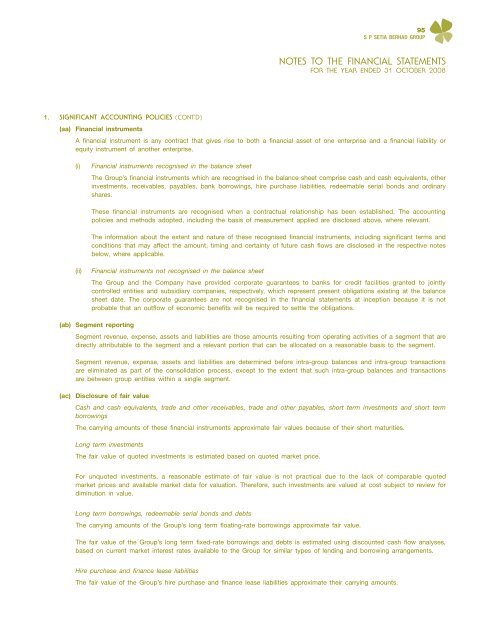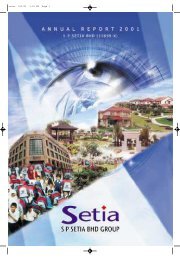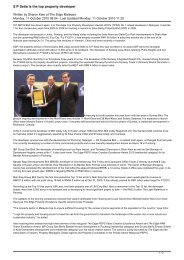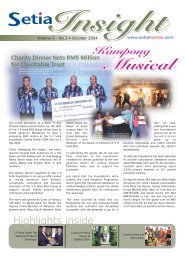Change - S P Setia Berhad
Change - S P Setia Berhad
Change - S P Setia Berhad
You also want an ePaper? Increase the reach of your titles
YUMPU automatically turns print PDFs into web optimized ePapers that Google loves.
95<br />
S P <strong>Setia</strong> <strong>Berhad</strong> Group<br />
NOTES TO THE FINANCIAL STATEMENTS<br />
FOR THE YEAR ENDED 31 OCTOBER 2008<br />
1. SIGNIFICANT ACCOUNTING POLICIES (cont’d)<br />
(aa) Financial instruments<br />
A financial instrument is any contract that gives rise to both a financial asset of one enterprise and a financial liability or<br />
equity instrument of another enterprise.<br />
(i)<br />
Financial instruments recognised in the balance sheet<br />
The Group’s financial instruments which are recognised in the balance sheet comprise cash and cash equivalents, other<br />
investments, receivables, payables, bank borrowings, hire purchase liabilities, redeemable serial bonds and ordinary<br />
shares.<br />
These financial instruments are recognised when a contractual relationship has been established. The accounting<br />
policies and methods adopted, including the basis of measurement applied are disclosed above, where relevant.<br />
The information about the extent and nature of these recognised financial instruments, including significant terms and<br />
conditions that may affect the amount, timing and certainty of future cash flows are disclosed in the respective notes<br />
below, where applicable.<br />
(ii)<br />
Financial instruments not recognised in the balance sheet<br />
The Group and the Company have provided corporate guarantees to banks for credit facilities granted to jointly<br />
controlled entities and subsidiary companies, respectively, which represent present obligations existing at the balance<br />
sheet date. The corporate guarantees are not recognised in the financial statements at inception because it is not<br />
probable that an outflow of economic benefits will be required to settle the obligations.<br />
(ab) Segment reporting<br />
Segment revenue, expense, assets and liabilities are those amounts resulting from operating activities of a segment that are<br />
directly attributable to the segment and a relevant portion that can be allocated on a reasonable basis to the segment.<br />
Segment revenue, expense, assets and liabilities are determined before intra-group balances and intra-group transactions<br />
are eliminated as part of the consolidation process, except to the extent that such intra-group balances and transactions<br />
are between group entities within a single segment.<br />
(ac) Disclosure of fair value<br />
Cash and cash equivalents, trade and other receivables, trade and other payables, short term investments and short term<br />
borrowings<br />
The carrying amounts of these financial instruments approximate fair values because of their short maturities.<br />
Long term investments<br />
The fair value of quoted investments is estimated based on quoted market price.<br />
For unquoted investments, a reasonable estimate of fair value is not practical due to the lack of comparable quoted<br />
market prices and available market data for valuation. Therefore, such investments are valued at cost subject to review for<br />
diminution in value.<br />
Long term borrowings, redeemable serial bonds and debts<br />
The carrying amounts of the Group’s long term floating-rate borrowings approximate fair value.<br />
The fair value of the Group’s long term fixed-rate borrowings and debts is estimated using discounted cash flow analyses,<br />
based on current market interest rates available to the Group for similar types of lending and borrowing arrangements.<br />
Hire purchase and finance lease liabilities<br />
The fair value of the Group’s hire purchase and finance lease liabilities approximate their carrying amounts.

















